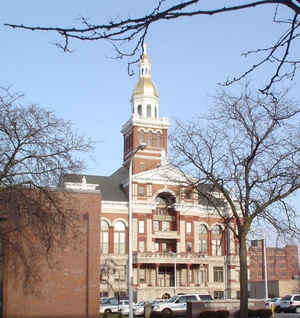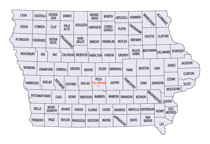Iowa Counties
There are ninety-nine counties in Iowa. The first two counties, Des Moines County and Dubuque County, were created in 1834 when Iowa was still part of the Michigan Territory. In preparation for Michigan's statehood, part of Michigan Territory was formed into Wisconsin Territory in 1836]. Two years later, the western portion was split off to become Iowa Territory. The south-eastern part of Iowa Territory became Iowa, the 29th state in the union, on 28 December 1846, by which point 44 Counties had been created. Counties continued to be created by the state government until 1857, when the last county, Humboldt County, was created.Dubuque County, Iowa
Dubuque County Education, Geography, and History
Dubuque County is a county located in the state of Iowa. Based on the 2010 census, the
population was 93,653. Dubuque County was
created on October 1, 1834. The county seat is Dubuque.
The county is named for Julien Dubuque, the first European settler of Iowa.
Dubuque County comprises the Dubuque, IA Metropolitan Statistical Area, and is the seventh largest county by population in the state.
Etymology - Origin of Dubuque County Name
Dubuque county is named for Julien Dubuque, the first European settler of Iowa.
Demographics:
County QuickFacts: CensusBureau Quick Facts
Dubuque County History
The land that is now Dubuque County
was first claimed by the white man in 1541. France, represented by Father
Marquette and trapper Louis Joliet, was the first to claim the land for its own,
in 1674. At the close of the French-Indian War in 1763, France ceded to Spain
the right to all territory West of the Mississippi. The vast region then know as
Louisiana was turned back to France in 1800, to become a part of the United
States by purchase from Napoleon in 1803.
In the early formation of Iowa there were only two counties. One was Demoine
County and the other was Dubuque County. Dubuque County and the county seat,
Dubuque, are both named for Julien DuBuque, the first white settler of Iowa.
In the second session of the Wisconsin Territorial Legislature, Dubuque County
was subdivided into 14 other counties: Benton, Buchanan, Cedar, Clayton,
Clinton, Delaware, Fayette, Jackson, Johnson, Jones, Keokuk, Linn, Scott, and
Dubuque. So Dubuque County originally embraced more than half of the future
State of Iowa, but was reduced to its present limits in 1837.
There was no question as to the location of the county seat when the county was
established and organized in 1834. The City of Dubuque was established in 1833,
making it the oldest settlement and county seat in Iowa. Dubuque was also the
location of Iowa's first church and the first newspaper published in Iowa (The
Dubuque Visitor, which began on May 11, 1836.) Since its inception the city has
been under five flags: the French, Spanish, English, the Imperial Flag of
Napoleon Bonaparte, and Old Glory of the United States after the Louisiana
Purchase in 1803.
The first official meeting of the Dubuque County Board of Supervisors was held
and the proceedings thereof recorded in the county auditor's office on May 13,
1836, probably the earliest such record preserved in the State of Iowa.
The first Court House built in the county was completed in 1836. The 20-foot x
26-foot hewed-log structure was basically used as a jail and soon became
outdated. It was then replaced by a brick structure, completed in 1843. After
overcoming considerable opposition from taxpayers', construction of a third
Court House was begun in 1891. Since it took nearly two years to complete the
Court House, the county offices were temporarily held in the city hall.
The Dubuque County Court House is a perfect example of Dubuque's early Victorian
architecture. The structure was designed by a native of Dubuque, architect
Fridolin Heer. When the building was constructed, 12 massive figures were placed
on the roof and ledges, at a cost to the county of $29,503.97. Since that time
all but six statues remain, the most prominent being Justice which rises above
the street more than 200 feet on the dome.
The climax of a complete renovation of the Court House between the years 1975
through 1984 was the gilding of the Court House dome through private donations.
Re-gilding was done, again through private donations, in 1994. The Court House
golden dome now dominates the Dubuque skyline.
Countless attempts have been made to construct a building combining city and
county governments. The first came in 1949 when the federal government drew up
plans for a building. This proposal failed, as have all the others dealing with
this idea.
The Dubuque County Court House was placed on the National Register of Historic
Places in 1966, the first building to be placed on the Register in the State of
Iowa. In 1989, the neighboring Egyptian-style Old Jail, designed by John Rague,
was designated as a National Historic Landmark by the United States Department
of the Interior. The Old Jail is currently leased to the Dubuque County
Historical Society.
In 1973, the County and City were successful in partnering for the construction
of joint law enforcement center, including a 46-bed jail, located across the
street from the original Jail and the Court House. In 2001, construction was
started on an addition to the center, which includes an additional 152-beds.
Sources:
Dubuque, Its History and Background., Dubuque County Historical Society, JoAnn
Reynolds, Dubuque County Recorder; 1990
Denise Dolan, County Auditor; and Jan Hess, Administrative Assistant to the
Board of Supervisors; 2002
Geography: Land and Water
The county borders on Illinois and Wisconsin, and is bounded on the northeast by the Mississippi River. According to the US Census
Bureau, the county has a total area of 617 square miles (1,600 km2), of which 608 square miles (1,570 km2) is land and 8.3 square miles (21
km2) (1.4%) is water. The county is drained by north and south forks of the Maquoketa River.
Dubuque county is located in east Iowa. Eastern Dubuque
County is different from the western part of the county in that the topography is very uneven. The city of Dubuque and surrounding areas
adjacent to the Mississippi River have many steep hills, bluffs, and ravines.
The eastern portion is more heavily wooded than the west,
which is mostly rolling farmland.
Dubuque County is widely known for its impressive bluffs along the Mississippi River, which run along the entire length of the county's
riverbanks. These form part of Iowa's Coulee Region, otherwise known as the
rugged Driftless Area.
Neighboring Counties
Bordering counties are as follows:
- Northeast: Grant County, Wis.
- East: Jo Daviess County, Ill.
- Southeast: Jackson County
- Southwest: Jones County
- West: Delaware County
- Northwest: Clayton County
Education
Capri Cosmetology College
Clarke University
Divine Word College
Emmaus Bible College
Loras College
Northeast Iowa Community College
University of Dubuque
Wartburg Theological Seminary







